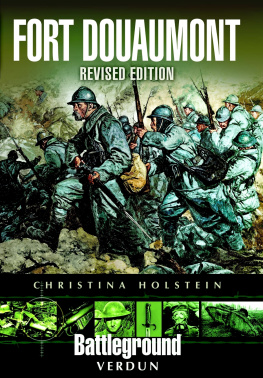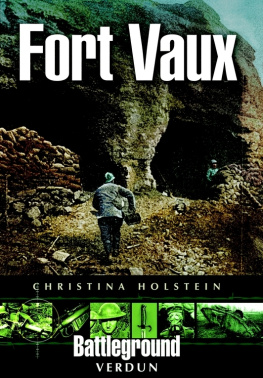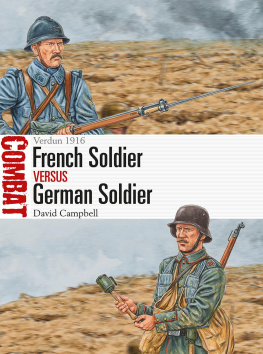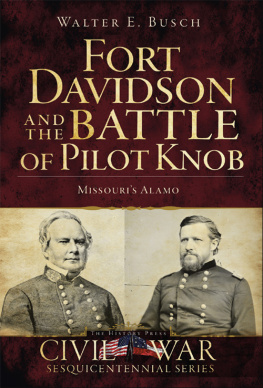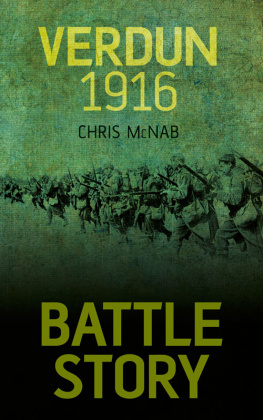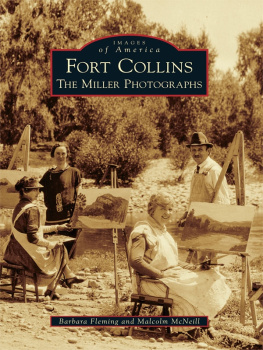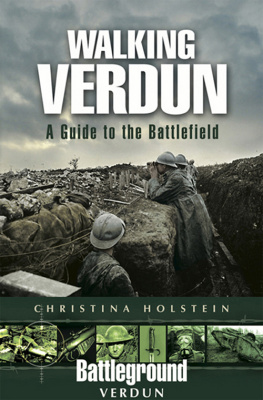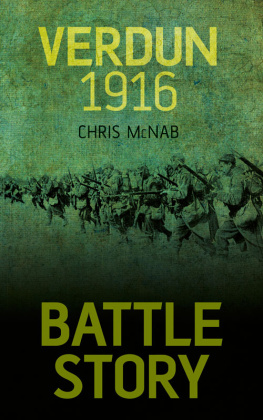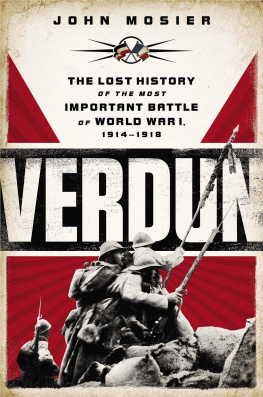ACKNOWLEDGMENTS
Without email and the internet, it would not have been so easy to write this book. These days, more and more archives and libraries are accessible online, historical discussion forums turn up information and along the way contacts are acquired and friends made. I must here acknowledge the very great debt that I owe to both old and new friends for the help that I have received in delving into the history of an aspect of the Battle of Verdun whose significance cannot be overestimated.
My thanks are due first to Nigel Cave for inviting me to join the growing list of authors of the Battleground Europe series and to Paul Reed for suggesting my name. Secondly, I owe a particular debt to Geoff Mangin, Gene Fax and Burleigh Randolph, who read through the entire manuscript and made many helpful suggestions. Their time and expertise was invaluable and saved me from error on many occasions. Particular thanks are due to Geoff Mangin, who read the drafts many times and whose thoughts and ideas accompanied my research from the beginning.
My initial fear of reading volumes of German Gothic script disappeared as the months went by and I made the acquaintance of historians of the German side of the story of Fort Douaumont, from whom I have learnt a great deal. In particular, I am indebted to Marcus Massing and Jan Carel Broek Roelofs, whose great generosity with books, photos and information has provided me with a wealth of unusual detail, including eye witness accounts of many events inside the fort. It is also through Jan Carel that I have had access to the archive of the late H.P. von Mller a historical treasure trove if ever there was one.
Many other people helped me. At the Mmorial de Verdun I was assisted in many ways by Isabelle Remy and Antoine Rodriguez. Their knowledge of the archives and their interest in the project greatly facilitated my research, particularly in its early stages. M. Jean-Paul Renaudin of the Bibliothque Municipal de Verdun kindly provided me with plans of the fort and the gun turrets. At the Service Historique de lArme de Terre, Paris, my path was smoothed by Adjudant-Chef Philippe Lafargue who gave up much time to show me around and to help me identify the documents I needed. On my trips to Paris I was fortunate in being able to stay with old friends, M. and Mme. Michel de Briey, who probably never thought that their au pair girl of thirty years ago would turn out to have so deep an interest in concrete and steel. From Seattle Tom Gudmestad sent books and photos and turned up some unusual information, as did my old friend and Verdun guide, Ingrid Ferrand. To my delight, Ingrid was also instrumental in persuading Madame Murile Sztermer, Director of the Maison de Tourisme at Verdun, to allow me to enter and photograph those parts of the fort that are normally closed to the public. I was accompanied on that exciting occasion by Jean-Luc Kaluzko, whose wonderful photos add so much to this book, and by Rudy Zapp, guide at Fort Douaumont for twenty five years. Photographs of Fort Douaumont and of other aspects of the Battle of Verdun were also supplied by the Mmorial de Verdun, the Service Historique de lArme de Terre, Paris, the Bundesarchiv Koblenz, the Imperial War Museum, London, and, in particular, by the Liberty Memorial Museum in Kansas. I was surprised to find that a museum in Missouri would have so many images of Verdun and I am grateful to Doran L. Cart, Curator, for providing them. Every effort has been made to trace the copyright owners of photographs used in this book and the author and publishers apologise for any omissions. Mitchell Yockelson of the National Archives and Records Administration, College Park, Maryland, searched for information concerning American visitors to Fort Douaumont in 1918, despite the very few details that I was able to give him. Martin van Olphen dealt patiently with a number of small but tiresome points concerning the design or original purpose of certain parts of the fort. Len Shurtleff was untiring in providing online definitions of fortification terms from his military technical dictionary. Geoff Stevens drove my planned car tour and checked many details that I had overlooked. My children were a great support. Anna put up gamely with a mother who was suddenly permanently linked to a computer. Isabella provided the first maps and Valdemar was a frequent companion on walks and explorations. When Valdemar was unavailable for walks his place was taken by Jean Poole, whose enthusiastic support for this project has never waivered.
Finally, I owe a particular debt to the extended Randolph family, whose combined engineering knowledge not only supplied answers to many obscure questions but also provided much laughter along the way. In that respect, special mention must be made of Mark Randolph for a surprising discussion, with equations in support, of the ricocheting potential of a 420mm shell that had already travelled approximately six miles. To him, and to all those who assisted me in this project, my grateful thanks are directed. The responsibility for any errors is mine alone. Luxembourg, February 2002.
Select bibliography
French sources
On Fort Douaumont
Monographie du Fort de Douaumont , contained in Verdun et ses forts pendant la guerre , General G. Benoit, 1929, (Archives du Memorial de Verdun)
Etat du Fort de Douaumont la date du 26 Octobre 1916 , handwritten report by Lieutenant Manhs, (Archives du Memorial de Verdun)
Rapport du Lieutenant-Colonel Benoit au sujet des effets du bombardment sur les fortifications de Verdun, in Les Armes Franaises dans la Grande Guerre, Service Historique, Ministre de la Guerre, Tome IV Vol. 3, Annexes - Volume 1, p. 22 (Paris, Imprimerie Nationale, 1926)
Travaux executs Douaumont aprs la reprise du fort , report by Captain Gilson, Revue du Gnie Militaire, 1928
Douaumont 24 Octobre 1916, Gaston Gras (Les Editions Lorraines, Frmont, Verdun).
On the Verdun forts
De lOppidum lEnfouissement: LArt de la Fortification Verdun et sur les marches de lEst (Comit National du Souvenir de Verdun, Memorial de Verdun 1996)
Verdun dans le Systme Fortifi Sr de Rivires, Conference paper by Jacques Grasser at the international conference on the Battle of Verdun, 6-8 June 1975 (Memorial de Verdun)
Verdun, Les Forts de la Victoire , Guy Le Hall (Citdis 1998; ISBN 2-911920-10-4)
La Lorraine fortifie , Stphane Gaber (Editions Serpenoise, 1997; ISBN 2-87692-326-2).
On the Battle of Verdun
Les Armes Franaises dans la Grande Guerre, Service Historique, Ministre de la Guerre, Tome IV: Verdun et la Somme, Vols.1, 2 and 3 (Paris, Imprimerie Nationale, 1926)
Verdun 1916 , Jacques Pricard (Nouvelle Librairie de France, 1947)
Regimental histories: 129th Infantry, 74th Infantry, 36th Infantry, 34th Infantry, 3rd Gnie, Regiment dInfanterie Coloniale du Maroc.
German sources
On Fort Douaumont
Schlachten des Weltkrieges, Vol. 1: Douaumont , Werner Beumelburg, Verlag Gerhard Stalling, Oldenburg/Berlin, 1925
Douaumont wie es wirklich war , Eugen Radtke (Frundsberg-Verlag)
Die vom Douaumont: Das Ruppiner Regiment 24 im Weltkrieg Cordt von Brandis,
(Verlag Tradition Wilhelm Rolf, 1930)
Vor uns der Douaumont Cordt von Brandis (Druffel Verlag)
Seelenkrfte im Kampf um Douaumont Kurt von Klfer (Verlag Die Brcke, Berlin, 1938).
On the Battle of Verdun
Der Weltkrieg 1914-1918, Vol 10: Die Operationen des Jahres 1916; Vol. 11: Die Kriegfhrung im Herbst 1916 und im Winter 1916/17 (Reichsarchiv/Kriegsministerium, Berlin, E S Mittler & Sohn, 1938)
Schlachten des Weltkrieges, Vol. 13 - Die Tragdie von Verdun 1916 I. Teil Die Deutsche Offensivschlacht , Ludwig Gold, (Oldenburg/Berlin, Verlag Gerhard Stalling, 1926)
Regimental histories: 24th Infantry Regiment, 12th Grenadiers, 8th Leibgrenadiers, 3rd Rheinisches Pionier-Bataillon No. 30.

